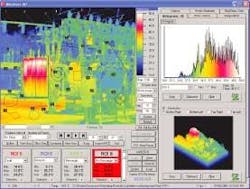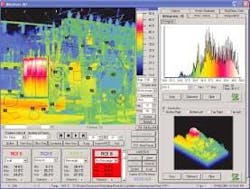IR cameras remotely monitor power-generation plants
The power and gas industries generally use heavy equipment, such as transformers and chemical crackers, in their facilities that must be closely and continuously monitored for high temperatures. In these facilities, computer control rooms are often remotely located from the equipment and contain demanding measurement systems that are deployed on-site and remotely monitored.
"In the past," says Jon Chynoweth, vice president of sales of the thermal imaging division of Mikron Instrument Co. (Oakland, NJ, USA; www.mikroninst.com), a manufacturer of thermal-imaging cameras and process-control systems, "thermocouple grids were applied at strategic points to provide 100% coverage of the equipment temperatures." These thermocouples were linked via fiberoptic interfaces to remotely located computer-based monitoring equipment. "Although the thermocouple approach does provide a solution to temperature monitoring," says Chynoweth, "when repairs to the facility need to be made, complete thermocouple grids need to be removed and replaced; this process is both time consuming and costly."
Infrared monitoring
To overcome these problems, Mikron has developed an infrared (IR) system to perform remote process monitoring. The system can use up to 14 of the company's MikroScan TS7302 8- to 14-µm microbolometer-based IR cameras fitted with 0.6x wide-angle germanium lenses to provide 100% coverage of the plant equipment.
The TS7302 cameras are fed to a 16-port 10/100Base-T SuperStack 3 Baseline Ethernet switch from 3Com (Santa Clara, CA, USA; www.3com.com). Outputs from the switch are then transferred over the facility's Ethernet network to a Tsunami QuickBridge wireless router from Proxim (Sunnyvale, CA, USA; www.proxim.com). This wireless point-to-point networking system uses preconfigured bridges that allow a wireless LAN extension to be installed between the two locations.
The cameras capture 320 × 240-pixel images that are delivered more than a mile to a receiving station. Here, the Ethernet images are transferred to a host Pentium-based PC running 14 instances of Mikron's Mikro.Spec R/T thermal image-processing and report-writing software.
"By polling each camera's IP address every second," says Chynoweth, "IR images from every camera can be transferred through the wireless slave router to the host server in approximately 14 s. Here, several operations can be performed on the image including image calibration, filtering, statistical analysis, and regions of interest.
Based on threshold parameters preset for the images, alarms can be activated to alert the facility operator should a temperature measurement exceed or fall below a particular value. "Although the total cost of such a system slightly exceeds the cost of a multiple thermocouple-based solution" says Chynoweth, "cost savings are realized as soon as any maintenance needs to be performed, since the IR-based system is noncontact."

